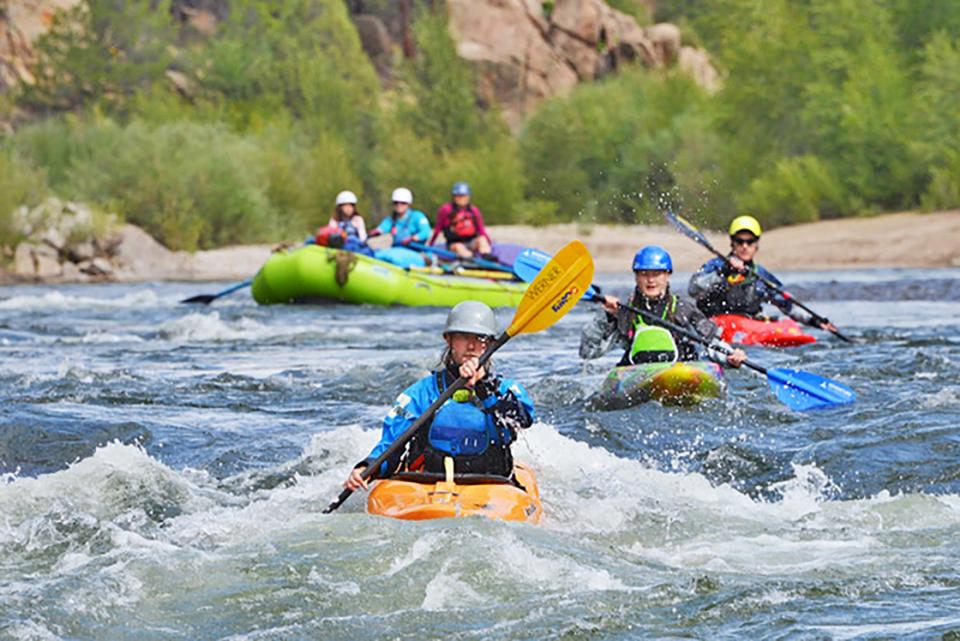Area snowpack is back above normal. Here's how that could impact water users in Pueblo.

Snowpack in the Arkansas River watershed basin jumped this week from less than a third of normal levels to just above 100% thanks to late spring snow and rainfall.
The change has eased fire bans and brought steady early season flows to the Arkansas River, which is good for the multimillion-dollar rafting business in the region. However, the long-term outlook could still be dry for Pueblo and other counties in southeastern Colorado.
“As much as I would like to declare the drought is over, it’s not,” said Chris Woodka, senior policy and issues manager for the Southeastern Colorado Water Conservancy District. "Given factors like the low soil moisture, early runoff and windy conditions we have seen this spring, the recent precipitation has helped, but we will need a few more good soakings to turn things around.”
The seasonal forecast calls for drier and hotter than normal weather for the next few months and possibly through the end of the year, Woodka said. Arkansas River basin reservoir storage, which holds water supplies for many municipalities, is below normal in many areas, including Pueblo where the reservoir is at 64% of capacity.
Officials expect to import about 80% of the Fryingpan-Arkansas Project water used in southeastern Colorado. The project brings in supplemental water to users from Leadville to Lamar.
About half of the imported water, coming from the Colorado River basin, has already been brought in, Woodka said.
More climate news: Despite late May moisture, drought persists in Pueblo and the Arkansas River basin
Pueblo County received 2.33 inches of moisture from three storms in May, following below-normal precipitation in April, according to the National Integrated Drought Information System.
Fire bans were lifted in May, but officials cautioned the respite from burn restrictions might not last.
"This is probably just a brief reprieve from fire bans and we may be going back on them again if we don't get continued humidity or moisture," said Capt. Woody Percival of the Pueblo Fire Department.

Will snowmelt boost water flows on the Arkansas River?
Rafting outfitters are hoping for a slow, sustained spring runoff season as the snowpack melts.
“We want it to come slow and have enough water — that's way better than huge water all at once and too high of flows,” said Bob Hamel, a rafting outfitter and Arkansas River Outfitters Association executive director.
“We should have fun levels for rafting in all sections of the river this summer,” he said.
This week, the river was running about 1,200 cubic feet per second in Browns Canyon and 1,520 to Big Horn Sheep Canyon and the Royal Gorge.
“To see these flows in the first week of June is great,” he said. “But you can’t just look at the SNOTEL survey sites in May and predict what is going to happen — there may be no snow in some places but plenty of snow in the snowfields that endure through the spring.”
Snow that has dust on it because of recent high winds, soil moisture content, and weather conditions all impact runoff rates. If the soil remains dry, much of the melting snow would soak into the ground. Hot and dry conditions could lead to a lot of evaporation, instead of runoff and an increase in water on the river, Hamel said.
Water managers go with the flow
Arkansas River water managers participate in the Voluntary Flow Management Program, overseeing water releases July 1 through Aug. 15 to support boating conditions.
Voluntary Flow Management water releases also protect fishery health in the winter. This summer, water releases are expected after July 1 to support recreational boating, according to the Arkansas River Watershed Collaborative.
The management program has been buoyed by the Pueblo Board of Water Works' willingness to “move more of its water between July 1 to Aug. 15. Another thing that is unique this year is they have offered to move water in June if that’s what we really need,” Hamel said.
“That has never happened. They understand the connection with the river and the communities along it and realize what is good for rafting is good for other activities and businesses,” Hamel said.
Rafting is big business in the region. Last summer it brought $42 million in visitor expenditures as outfitters took 262,357 commercial trips on the river, according to an Arkansas River Outfitters Association report.
Hamel expects this year won’t match 2021, when rafting was one of the few outdoor adventures visitors considered safe for people to participate in during the COVID-19 pandemic. Concerts, festivals and sporting events have returned this summer and will compete for patrons' dollars.
Factors such as inflation and gas prices also will have an impact on leisure spending.
“But people like to raft, so we expect a good, solid rafting season,” he said.
More water news: Pueblo West's big water users would pay double under revised plan
Chieftain reporter Tracy Harmon covers business news. She can be reached by email at tharmon@chieftain.com or via Twitter at twitter.com/tracywumps.
This article originally appeared on The Pueblo Chieftain: Pueblo welcomes late spring moisture, but drought could persist?

